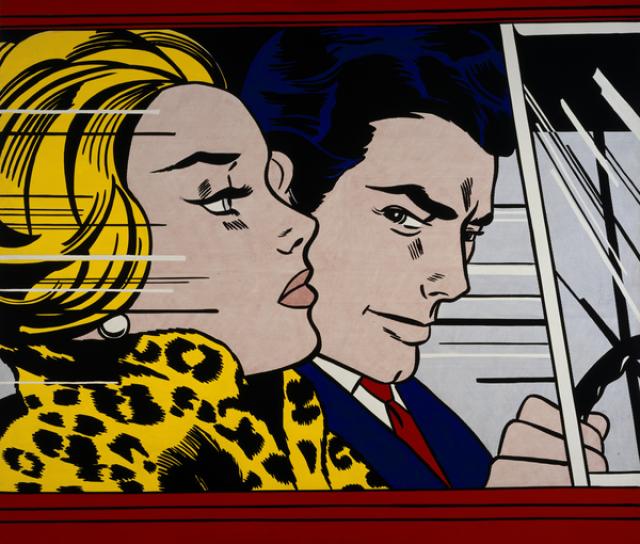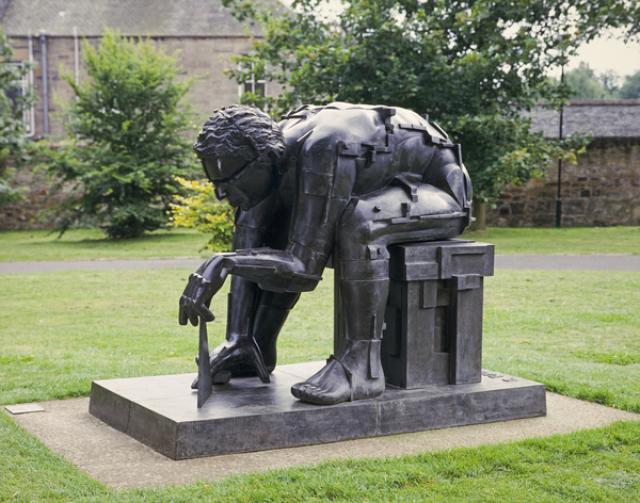An art movement of the 1950s to the 1970s that was primarily based in Britain and the United States. Pop artists are so called because of their use of imagery from popular culture. They also introduced techniques and materials from the commercial world, such as screen-printing, to fine art practice.
Video: What is Pop Art?
The Origins of Pop Art
Pop Art emerged in the decade or so following the Second World War, primarily in Britain and the United States. It is so called because artists explored imagery from popular culture. Following a period of post-war austerity, the movement focussed on the glamour of commercial design and media culture, speaking of optimism and possibility. Many Pop artists, particularly in the United States, reacted against the earlier, introspective language of Abstract Expressionism, aiming for mass appeal by blending elements of popular culture, through collage and printmaking, with traditional painting techniques.
The Independent Group and the emergence of Pop Art in Britain
From the early 1950s, a group of artists and writers called the ‘Independent Group’ would meet in London’s Institute for Contemporary Art to discuss the growing culture of movies, advertising and consumerism emigrating from the United States. Members included Eduardo Paolozzi, Richard Hamilton, Lawrence Alloway, and Alison and Peter Smithson. It is thought there are several origins for the term ‘pop’, as written about by Alloway, Smithson and Hamilton. Paolozzi also made use of the word in a collage titled I Was a Rich Man’s Plaything, 1947. His collages from the 1940s and 1950s are now often referred to as ‘proto-pop’ and his innovative lecture ‘Bunk’ at the Institute for Contemporary Arts in 1952 followed similar ideas.

Eduardo Paolozzi,
I Was a Rich Mans Plaything, 1947
© Trustees of the Paolozzi Foundation, Licensed by DACS 2017.
In 1956 Hamilton attracted international attention with his collage, Just What is it that makes today’s homes so different, so appealing, 1956. Created for the group exhibition This is Tomorrow in 1956 at Whitechapel Gallery in London, the work takes a satirical approach to the new, superficial ‘American way of life’. In 1957 Hamilton wrote a letter to Alison and Peter Smithson outlining Pop’s characteristics as:
‘Popular, transient, expendable, low cost, mass-produced, young, witty, sexy, gimmicky, glamorous, and Big Business.’
- Richard Hamilton
Neo-dada and Pop Art in the United States
In New York, by the 1950s artists had begun to explore popular culture in Neo-Dada , Funk, Beat and Performance styles. Prominent names to appear included Jasper Johns, Robert Rauschenberg, Roy Lichtenstein and Andy Warhol, who emerged through a number of solo exhibitions. In 1962 the Sidney Janis Gallery in New York held the international exhibition New Realists with artists exploring such pop themes as the ‘daily object’, ‘mass media’ and ‘repetition’. Alloway, who had moved to New York to be a curator at the Guggenheim Museum, introduced the British term ‘pop’ to define this new era in art, which would spread through the rest of The Unites States and Europe.
Andy Warhol: Pop’s poster boy
Many of the iconic Pop images from The United States were produced by Andy Warhol and his name has become synonymous with the style. Warhol famously replicated brands such as Coca Cola and Campbell’s Soup along with images of celebrities such as Marilyn Monroe, Jackie Kennedy and Elizabeth Taylor as mass produced multiples using silkscreening techniques, but he also made films, digital artworks, paintings and sculptures. The name of Warhol’s studio, The Factory, referenced his mass produced artworks. Warhol’s attitude that art and life should be interconnected continues to influence contemporary practice today.
Pop Art in Europe
In France, Pop Art emerged in the form of Nouveau Realism defined by critic Pierre Restany as ‘new ways of perceiving the real.’ Artist Arman rejected his earlier abstract style of painting in favour of creating sculptures from found or discarded manufactured objects. In Germany, the term Capital Realism came to define artists influenced by American Pop, founded by Sigmar Polke and including members Gerhard Richter and Konrad Lueg, who examined and dissected popular culture imagery and photography with a knowing irony. In the UK, Pop continued to develop in London, with exponents including David Hockney, Joe Tison and Billy Apple.
What happened to Pop Art next?
The influence of Pop continued throughout the 1960’s and 70s, before being overshadowed by conceptual art, installation and performance. At the end of the 1970s and early 1980s Pop ideas began to resurface as Neo Pop, led by Jeff Koons, who celebrates American consumer culture and kitsch with outlandish paintings, sculptures and photographs. Takashi Murakami has also been linked to Neo Pop, with his appropriation of Japanese pop and fashion culture and his ‘superflat’ painting style. Both artists take a business-like approach to the production of art, employing assistants in large factories to produce merchandise, in a manner reminiscent of Warhol’s Factory in the 1960s.

 Eduardo Paolozzi, I Was a Rich Mans Plaything, 1947
Eduardo Paolozzi, I Was a Rich Mans Plaything, 1947












